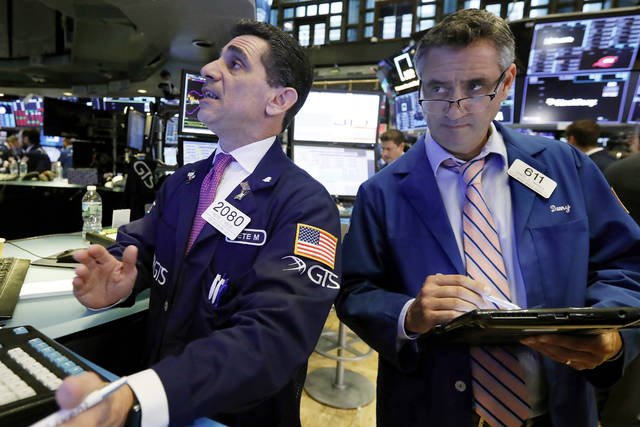NEW YORK — U.S. stocks slumped again Thursday as investors continued to sell shares of technology and internet companies, industrials, and companies that rely on consumer spending.
Several industrial companies tumbled after releasing weak quarterly reports, and European stocks also fell as European Union leaders criticized Italy’s spending plans.
At the start of trading, stocks took small losses as bond prices fell and interest rates spiked. While the gain in interest rates didn’t last, stocks turned lower late in the morning, and by the end of the day they had wiped away most of their big rally from Tuesday.
Stocks have skidded over the last two weeks, and there are signs investors are worried about future economic growth. The S&P 500 has fallen 5.5 percent in volatile trading since Oct. 3, and technology, industrial and energy companies have taken some of the biggest losses. Those companies tend to do better when the economy is growing more quickly and consumers and businesses have more money to spend.
“If uncertainty starts to creep in around trade or growth, that could be a risk to the recovery in … corporate spending,” said Jill Carey Hall, senior U.S. equity strategist for Bank of America Merrill Lynch. She said investors will monitor company reports over the next few weeks to learn about their business forecasts and plans.
European leaders expressed concern about the Italian government’s proposal to increase spending and widen its budget deficit. European Union budget chief Pierre Moscovici told Italy’s economic minister that the new government’s plans make it unlikely that Italy will be able to reduce its public debt to levels agreed upon by EU countries.
The S&P 500 index shed 40.43 points, or 1.4 percent, to 2,768.78. The Dow Jones Industrial Average lost 327.23 points, or 1.3 percent, to 25,379.45. It was down as much as 470 earlier.
The Nasdaq composite sank 157.56 points, or 2.1 percent, to 7,485.14. The Russell 2000 index of smaller-company stocks declined 28.85 points, or 1.8 percent, to 1,560.75.
Among industrial companies, aircraft maker Textron slid 11.3 percent to $57.49 after its profit and sales fell far short of analyst forecasts. The company said its aerospace and defense business and its industrial business both weakened. Tool and diagnostic equipment company Snap-on lost 9.6 percent to $151.47 after it posted lower revenue than analysts expected.
Industrial and basic materials companies have taken bigger losses than any other part of the market over the last month, and one reason is that investors feel they are especially vulnerable in the ongoing trade dispute between the U.S. and China. They’re already dealing with tariffs on imported steel and aluminum, which have increased their costs and can also hurt sales, and if the global economy slows, then manufacturing and construction could slow down, too.
Amazon pulled retailers lower as it lost 3.3 percent to $1,770.72. Video game maker Activision Blizzard lost 8.3 percent to $71.81 after it announced early sales numbers from “Call of Duty: Black Ops 4,” and Apple fell 2.3 percent to $216.02.
Those are some of the sectors that have fared the worst recently. The stocks that have held up the best include utility and household products companies. They don’t depend as much on economic growth, as consumers are likely to use about the same amount of electricity and buy the same amount of toilet paper or cereal regardless of the state of the economy.
The recent gains for those stocks is notable because the market’s slump began when interest rates started rising quickly. Defensive stocks often struggle when interest rates are rising. The companies are known for paying big dividends, similar to bonds, so when rates rise, investors often sell those stocks and buy bonds instead.
Carey Hall said that if the economy keeps growing and interest rates rise, investors might not want to choose between growth-oriented stocks or defensive ones. She said companies in the middle might do best, including some industrials, banks and older technology companies. Those companies could perform still benefit if the economy keeps growing, but they also have enough financial flexibility to raise their dividends to outpace rising interest rates.
Bond prices ended slightly lower. The yield on the 10-year Treasury note 3.18 percent from 3.17 percent.
In Europe, Italy’s FTSE MIB dropped 1.9 percent and Italian government bond prices dropped again, sending yields to their highest levels since February of 2014. Germany’s DAX dipped 1.1 percent. The French CAC 40 lost 0.5 percent and the FTSE 100 in Britain slipped 0.4 percent.
Japan’s Nikkei 225 index sank 0.8 percent and the Kospi in South Korea lost 0.9 percent. Hong Kong’s Hang Seng index was little changed, and remained near its lowest level since May 2017.
The price of U.S. crude oil lost 1.6 percent to $68.65 per barrel in New York, its lowest in a month. Brent crude, the international standard, lost 0.9 percent to $79.29 per barrel in London.
Wholesale gasoline fell 1.4 percent to $1.89 a gallon. Heating oil slid 0.7 percent to $2.29 a gallon. Natural gas dropped 3.7 percent to $3.20 per 1,000 cubic feet.
Gold rose 0.2 percent to $1,230.10 an ounce. Silver fell 0.4 percent to $14.60 an ounce. Copper lost 1.1 percent to $2.75 a pound.
The dollar dipped to 112.20 yen from 112.49 yen. The euro fell to $1.1465 from $1.1507.
————
AP Markets Writer Marley Jay can be reached at http://twitter.com/MarleyJayAP


